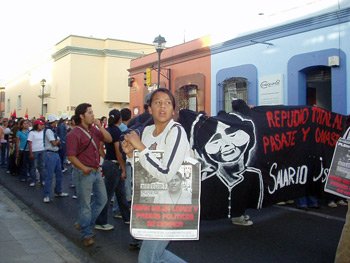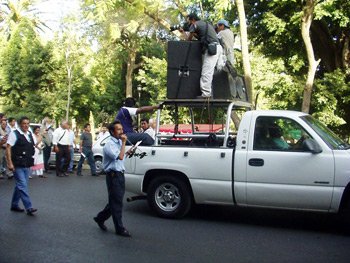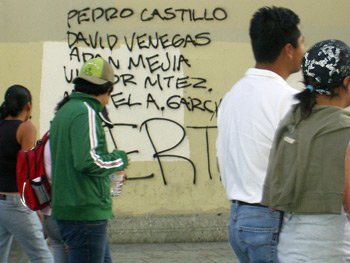


A New Strategy for the Popular Movement in Oaxaca?
Something for Everyone as the APPO and the Teachers Hit the Streets for 2008
By Nancy Davies
Commentary from Oaxaca
January 18, 2008
A well-planned movement march of Oaxaca local Section 22 of the Mexican teachers’ union (SNTE in its Spanish initials) and the Popular Assembly of the Peoples of Oaxaca (APPO) walked on January 16 from the stadium on Vasconcelos avenue at Niños Heroes de Chapultepec, to the zocalo in the center of Oaxaca, a distance of about two miles. Many parents carried children, and some little kids walked holding their mother’s hand. It was a day of “something for everyone”; the marchers represented the spectrum of civil society in Oaxaca. So did the solutions: demands to withdraw government imposition of higher costs or fewer benefits, and to maintain intact the historic city center.
 D.R. 2008 Nancy Davies |
Leading the march were two university youngsters I recognized, one of whom I’ll call Luis. Luis has told me he is a Stalinist; he wears braces on his teeth, which indicates his parents are middle-class (and they are teachers). I often see him around Florentino Lopez of the communist Popular Revolutionary Front (FPR), but today I didn’t see Florentino. Luis was sucking a lollypop as he strolled along. Except for dental care, that was a good sign: a relaxed atmosphere. I also spotted the head of the human rights organization LIMEDDH, Yesica Sanchez, at a street corner going to join the march, and among the several reporters I saw Pedro Matias of Noticias de Oaxaca, who always covers the APPO beat.
Behind the two lead youngsters, a truck moved along with a loudspeaker, with alternating speakers from the APPO and the teachers. Marcelino Coache of the APPO proclaimed the reasons for the march: most important, to protest the new “ISSSTE Law,” which is a national modification of social security benefits. That law affects all government employees, not just teachers, and is nationally opposed. Tomorrow, Coache informed us, 7,000 Oaxaca teachers will head to Mexico City to join protests there.
Directly behind the truck came the families of political prisoners. Five are still captive, although repeated court orders have declared invalid the grounds for keeping the two APPO men, Flavio Sosa and David Venegas. The Oaxaca government, as fast as the court throws out one allegation, files another criminal charge against those two. The accusations fluctuate but tend to focus around sedition and setting fires. Sosa was arrested in December of 2006; Venegas was grabbed in April of 2007 – guilty of offending the ruling powers.
The families were followed by a body of teachers who come from the Central Valley and the Sierra Norte regions. Some were obviously feeling the obligatory attendance required by union decisions; some seemed vigorous and willing to shout the often heard slogan “shoulder to shoulder, elbow to elbow, we are all the APPO” (hombro con hombro, codo con codo, la APPO, la APPO, la APPO somos todos), plus the newer slogans which demand the rescinding of the one-peso increase in bus fares.
 D.R. 2008 Nancy Davies |
Also at issue is the almost ludicrous business of the parking meters, and the closing off of streets in the center to expand the pedestrian mall. The new mayor of Oaxaca City, Hernandez Fraguas, (from Governor Ruiz’ Institutional Revolutionary Party) admits that the parking meters represent a fiasco – they’ve been installed and uninstalled several times since 2006. Hernandez notes that not only do people not want them (those who have cars, plus the shops which would lose business to commercial malls), but the contracted beneficiaries of the profits are a private firm. This fact hints at the typical graft on the part of government officials. The meter machines themselves are a violation of the preservation of the historic city center. So Hernandez says the “contract” will be rescinded – maybe.
And lest we forget, the demand for the ouster of URO continues and is “irrevocable”. The families of the dead, tortured and disappeared proclaim, “We don’t forget and we don’t forgive.”
The clever part of the APPO strategy in all this was to link the parking meters with the closing of additional streets. Expanding the tourist pedestrian mall can only benefit expensive shops, restaurant and hotel owners who, the newspaper Noticias reported, plan three more five-star hotels. (If that involves investment by an international hotel chain, no one is saying so yet.) Small commercial shop-owners (think of an aquarium store with three kinds of tropical fish; think of a clothing shop where nothing costs more than twenty dollars) fear the prospect of being driven out of business – and now they can thank the APPO for taking up their cause.
Behind the teachers came the APPO activists, followed by the youth group Front of Youth and Student Organizations, and students for whom the fare raise is an important issue. A gun battle actually took place at the state university campus this week, of “thugs versus thugs,” and Noticias identified the two rival gangs. Subsequently one gang, whose members were identified by name, called in death threats to Noticias reporters. The gang dispute was over whether or not to sequester and/or burn the buses on the campus. Who hired the two sets of thugs is not known, but clearly rival motives were in play. Urban transport is owned by private persons. The government sent police to end the battle.
Red flags with hammer and sickle as usual brought up the rear of the APPO march, while the graffiti boys, wearing masks against the spray paint, dodged alongside marking the walls with the names of the political prisoners and the recently disappeared. (Since summer of 2007 one indigenous Chatino man, Lauro Juarez, and two Triqui sisters, Daniela and Virginia Ortiz Ramirez, have been disappeared. Also protested were the older disappearances of two members of the Popular Revolutionary Army; and other human rights violations).
 D.R. 2008 Nancy Davies |
I spotted at least a hundred residents along the route who emerged to watch. Two men looked dismayed and frightened. Many looked bemused. Most looked curious and interested. That’s not what you would call a scientific study of Oaxaca public opinion, but my sense is that the public is united along the family’s economic issues, which the return of tourism in no way addresses; the APPO movement politic embraces their plight.
This seemed to me to be the best organized and most comprehensive march the APPO could have desired at this time in its existence. To revise the structure of the APPO and devise tactics to cope with the ongoing government of Ulises Ruiz, the council meets on January 19. The Popular Assembly of Oaxaca City neighborhoods meet this week, as does the Popular Assembly of the Isthmus of Tehuantepec. The important Oaxaca City issue: the neighborhoods, or colonias, elect representatives to the city council and don’t want PRIistas, or Institutional Revolutionary Party members. What they do want is an end to the neglect of streets, schools, and the water supply. The Isthmus is struggling with land and water issues caused by the foreign-owned wind-generators, the affects of the enlarged port infrastructure at Salina Cruz, and the juggernaut of “Plan Mexico.” This last, which is supposedly a war on narcotics, evokes at the moment the question of whether any of the Ministerial Police are not involved in drug trafficking; the murder rate has achieved horrendous proportions.
As the pundits endlessly repeat, since the causes of the 2006 uprising remain, the movement won’t vanish. That being so, it was nice to see that the APPO regrouping served well for the first megamarch of 2008: the more the problems, the more the community organizing.
Click here for more Narco News coverage of Mexico
Legga questo articolo in italiano
- The Fund for Authentic Journalism
For more Narco News, click here.




